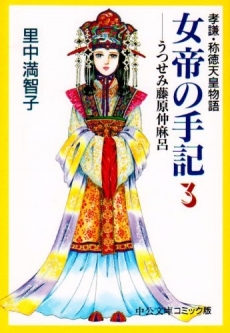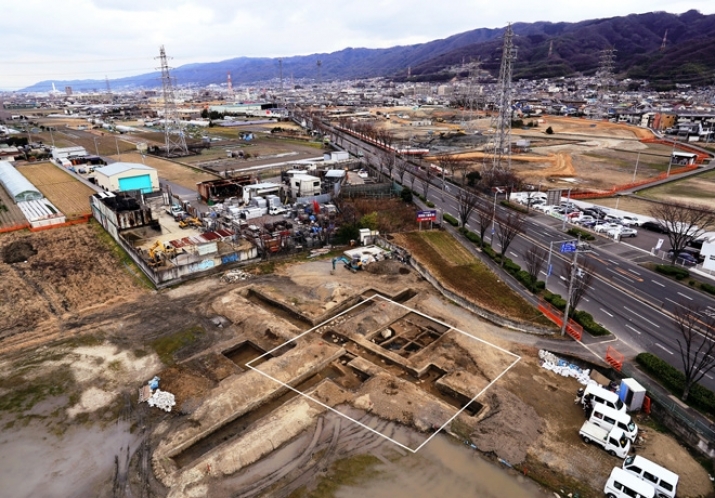A team of archaeologists in Osaka Prefecture have discovered the square foundation of a giant pagoda at the Higashi-Yuge archaeological site in the city of Yao. The Nara National Research Institute for Cultural Properties announced on 9 February that the discovery was believed to have supported an imposing pagoda that would have been part of a mysterious temple called Yuge-ji, which was said to have been built by a powerful Buddhist monk named Dōkyō (c. 700–72) during the Nara period in the 8th century.
Dōkyō was a spiritual heir to the East Asian Yogacara school, which was known in Japan as the Hossō sect or the Yuishiki-shū. While Hossō had already been consolidated by Dōshō (629–700), who was a student of the Chinese Yogacara master Xuanzang (fl. c. 602–64), Dōkyō represented the Yogacara school at its most influential as a beloved and favored courtier to the empress (tennō) Kōken (718–70), also known as Empress Shōtoku.
Although there are a few historical documents available about the temple, the research group and the Yao education board consider the square base to be important material evidence for the semi-legendary Yuge-ji complex. According to Kazuhisa Hakozaki, a researcher of ancient Buddhist architecture with the Institute, the size of the foundation means that a relatively large pagoda would have been built above it.
“The find was compared with remaining foundations of seven-story pagodas built as a part of official temple complexes around the country, as well as the foundation sizes of existing wooden five-story pagodas,” he said. “The square foundation, with sides 20 meters long, could have possibly held a 60-meter class, seven-story pagoda.” (The Asahi Shimbun)
Shoku Nihongi, an official historical text about the Nara Period (710–84) published during the Heian period (794–1185), contains a record of Yuge-ji. Hitoshi Minamoto, head of the cultural property department of the Yao education board, said: “Historical documents say there was a palace site called Yuge-no-miya (also known as Nishi-no-kyo) that was founded by Empress Shōtoku near Yugeji temple, so we would like to continue our research.” (The Asahi Shimbun)
 A Japanese manga depiction of Empress Shōtoku. From kanayi.com
A Japanese manga depiction of Empress Shōtoku. From kanayi.comWhile little of Dōkyō’s early life is known, he seems to have been a presence at the Nara court by 761, and during that year apparently healed an illness afflicting Empress Shōtoku.
This extraordinary woman, who was born to the aristocratic Fujiwara clan, was first enthroned as Empress Kōken, making her the 46th monarch of Japan, and following her second accession (shigusa) as Empress Shōtoku (she had deposed her own successor) was listed as the 48th.
A patron of courtly imperial Buddhism, she assigned a great number of small wooden pagodas each containing a woodblock scroll with the protective Hyakumantō Darani. (Wikipedia) She released a decree proclaiming that as an ordained Buddhist, her first duty was to serve the Buddha, but this would not interfere with her performance as the prime Shinto priestess whose duty was to make offerings to the ancestral deities. (Aoki 1991: 72–73)
She was famous for her deep confidence and trust in Dōkyō after his curing of her illness. She showered him with titles and appointments and he was rumored to have serenaded her the Buddhist scriptures in a sensual, sonorous voice. She consulted him on religious and secular matters alike, but this blatant favoritism led to armed civil strife. (Aoki 1991: 70–74) When she died in 770, Dōkyō was exiled to what is today Tochigi Prefecture.
Empress Shōtoku and Dōkyō’s story is a common trope in the history of powerful women and Rasputin-like priestly figures: a female sovereign or aristocrat loves a younger, attractive, and talented man, and their affair brings about the collapse of their empire. It is, however, also a story of politics, power, and romance: a remarkable tennō who reputedly asked her ladies-in-waiting why male emperors could take as many women as they wanted, while complaining—with a certain monk in mind—how empresses could not marry.
References
Aoki, Michiko Y. 1991. “Jitō Tennō”, in Chieko Irie Mulhern, ed. 1991. Heroic with Grace: Legendary Women of Japan. New York and London: East Gate: 40–76.
See more
Base for giant pagoda could be first proof of mystery temple (The Asahi Shimbun)
Empress Shōtoku (Imperial Household Agency)
Shigusa (Wikipedia)
Hyakumantō Darani (Wikipedia)
















